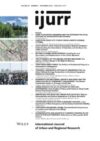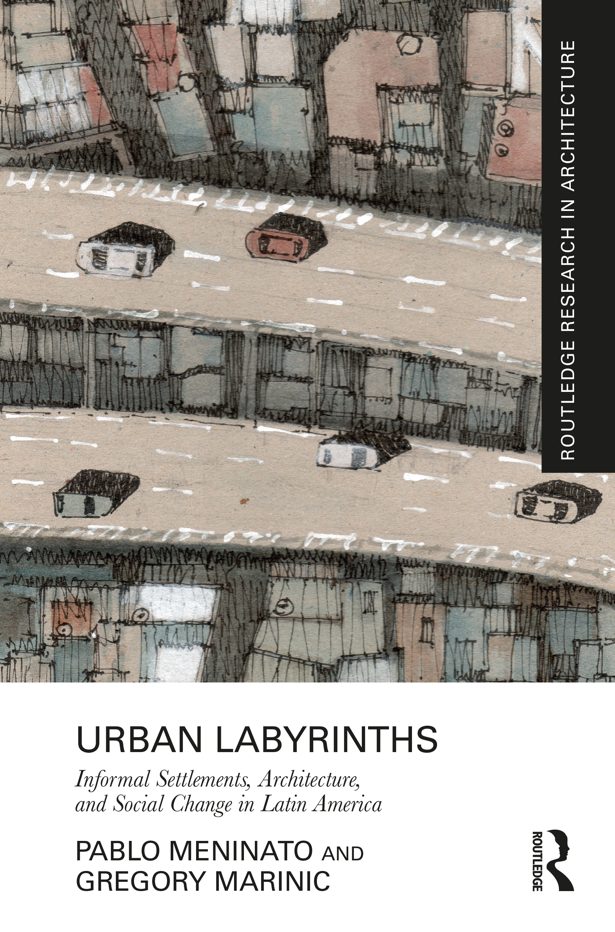At its core, Urban Labyrinths is an architectural design book—an obvious yet revealing statement about the authors’ approach to informal settlement upgrading in Latin American cities. Its nearly two hundred well-written and illustrated pages also serve as a caution for urban scholars seeking a more interdisciplinary approach.
The book revolves around two key arguments: how the logic of informal settlements has shaped new architectural design theories and methods, and the transformative potential of design in reshaping ‘marginalized communities’. The focus on Latin America is justified by the numerous experiences in the region since the 1960s.
Thus, although in the preface the authors state that the book is intended for scholars from various disciplines, someone seeking to understand the subject from the broad perspective of urban studies, urban planning or housing policy may end up frustrated. This is because the book does not investigate, at least not with the same weight (or rigor) given to architectural analysis, the political, sociological, land-related and historical aspects of the phenomenon of informal settlements and interventions in them.
For instance, the book largely attributes informal settlements to rural-to-urban migration, despite the latter’s decline since the late 20th century. Meanwhile, favela populations continue to grow due to structural urban poverty. Another commonly cited explanation throughout the book is the state’s failure to provide public infrastructure—despite the authors’ acknowledgment that most municipalities have deliberately avoided including such neighborhoods on their official maps (p. 9) and in planning regulations.
On the other hand, the enslavement and subsequent segregation of Indigenous and African peoples are factors much less explored by the authors, despite evidence that informal settlements throughout Latin America remain predominantly non-white. This is precisely why, contrary to the authors’ opinion, comparisons between Latin American cities and unplanned medieval European cities—even when limited to urban form—prove unproductive.
Each of the five chapters that follow the introduction addresses a Latin American city selected for the centrality given to architectural design in recent upgrading projects there: Rio de Janeiro, Medellín, São Paulo, Buenos Aires, and Tijuana. Each of these chapters follows the same formula: they begin with a rich geographical, historical and sociocultural contextualization of the urban development processes marked by the presence of informal settlements, provide some limited information on upgrading experiences before the 1990s and focus the analysis on more recent experiences, in which architectural design has gained greater importance: Favela-Bairro in Rio de Janeiro; PUI Nororiental and UVA de la Cordialidad in Medellín; the urbanization of the Paraisópolis and Cantinho do Céu favelas in São Paulo; Villa Tranquila and Villa 31 in Greater Buenos Aires; and two public space projects to improve the quality of life in informal settlements in Tijuana.
One initial criticism is that, despite this contextualization creating a rich environment for readers approaching the topic for the first time, a lack of historical accuracy, omissions and even errors in the recovery of experiences prior to those analyzed in detail pose risks to understanding the cumulative or incremental nature of informal settlement upgrading processes in Latin America.
There are also two central contradictions that stand out. The first, more immediate, contradiction is the adoption of the term ‘informal urbanism’ to refer to official projects for transforming underprivileged territories, promoted by municipalities, offices or universities. The second contradiction, evident in the book’s penultimate chapter, lies in the clash between, on one hand, the idea of correcting the urbanization processes of these territories through design and thereby catalyzing social change and, on the other, the exaltation of the spontaneous, flexible and sometimes ephemeral aesthetics of informal settlement architecture, drawing on the book Estética da Ginga, by the Brazilian author Paola Berenstein Jacques.
However, while the authors of Urban Labyrinths defend the idea of interventions capable of creating new centralities and aesthetic landmarks in favelas (‘the cathedrals of our time’), Berenstein Jacques, by contrast, criticizes the static preservation of favelas underlying programs like Favela-Bairro. For her, what matters in the aesthetics of favelas is not their forms but the processes that [trans]form them. Based on the conception of favelas as ‘territories in motion’, she proposes that interventions to improve quality of life should be minimal—almost non-interventions. Favelas, in her view, reveal a decentered, non-hierarchical and unstable culture that opposes the rational logic of architectural design.
Carlos Nelson dos Santos, another Brazilian author mentioned in the book as a major influence on the architects behind programs like Favela-Bairro in Rio de Janeiro and Guarapiranga in São Paulo, later argued that social interrelations and networks of meaning matter more to favela residents than material or practical considerations. Yet, he observed that the latter tended to dominate the perspectives of those intervening in these settlements. Perhaps it is precisely this lack of grounding in social interrelations and networks of meaning that often leads to projects being poorly maintained or abandoned by the population—not merely the absence of policies ‘aimed at educating residents on preserving and safeguarding these initiatives’ (p. 44).
For these reasons, the book’s main merit lies in redirecting the attention of architectural design professionals toward the theme of urban informality. The architects interviewed are part of a group of renowned professionals responsible for programs and projects to upgrade precarious settlements in which architectural projects for public buildings, squares and parks have been central to transforming the urban landscape.
In all the Latin American countries studied, architects are not a homogeneous professional class in terms of ideologies, even when working with informal settlements. The book ultimately presents the vision of a specific group committed to integrating the qualities of modern Western architectural projects into these vernacular territories. Therefore, it might be of great interest to those who similarly believe that modern design ‘‘‘beautifies” the urban environment’ and ‘creates a sense of pride and belonging’ (p. 68).
Camila Saraiva, Center for Favela Studies (CEFAVELA), Universidade Federal do ABC (UFABC)
Pablo Meninato and Gregory Marinic 2024: Urban Labyrinths: Informal Settlements, Architecture, and Social Change in Latin America. London and New York: Routledge.
Views expressed in this section are independent and do not represent the opinion of the editors.

